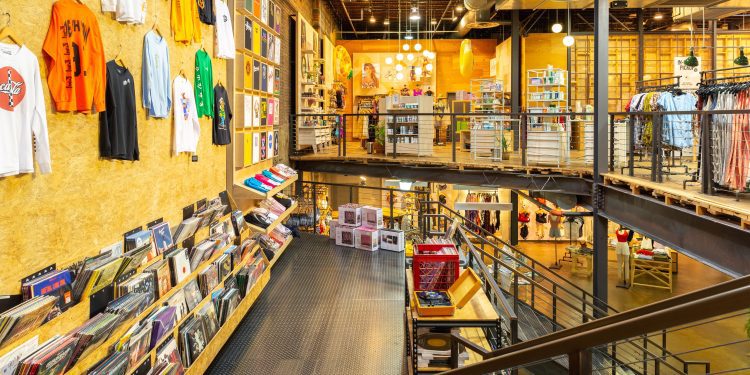Selling baggy jeans isn’t enough to win over Gen Z. Urban Outfitters, the young adult retailer known for its alternative, vintage-inspired styles, learned this the hard way.
During its most recent earnings call, the company candidly admitted it didn’t know how to market to the demographic that made it a household name — young people. Urban Outfitters is now staging a turnaround, with the ambition of finding the success of rivals like Abercrombie & Fitch.
Among its mistakes, the brand acknowledged missing the “rapid and seismic shifts” between millennials and Gen Z during the global pandemic.
“As these shifts occurred and a new generation began coming of age, we lost focus on our customer, and we lost track of how to win with them in today’s dynamic retail environment,” Shea Jensen, president of Urban Outfitters Brand in North America, said in an earnings call in August.
Because of that failure, Jensen said the company couldn’t gain new Gen Z customers while losing the millennials, but remains “optimistic about our ambition to become the definitive brand for young adults.”
Urban Outfitters — which is part of a conglomerate that includes Anthropologie, Free People and rental site Nuuly — faced a 9.3% drop in sales in the second quarter of 2024. Urban is a sore spot in the overall business; declining while the group’s total sales have grown 6% to a second-quarter record of $1.35 billion.
“It’s the job of any business to know their consumer, and I think there are plenty of businesses that are still growing revenues,” Simeon Siegel, managing director of equity research at BMO Capital Markets, said.
Now that the era of Covid stimulus has passed, “We’re back to a winners and losers environment. We’re back to market share,” Siegel added.
And in the world of retailers catering to the fickle fashion sensibilities of young people, the competition is fierce – especially for a retailer that was founded in the 1970s.
The price point at Urban Outfitters is significantly higher than fast fashion giants Shein and H&M, but it isn’t quite considered luxury, which thrives off exclusivity. Joining it in the middle-range are companies like Abercrombie & Fitch and American Eagle, which have both seen sales soar while Urban Outfitters has floundered.
Abercrombie & Fitch pulled off a successful brand turnaround, skyrocketing its stock more than 144% in the past year. But while Urban Outfitters may be trying to pull off a turnaround at the same scale is Abercrombie’s, the action points of both differ.
Northwestern University marketing professor Jacqueline Babb told CNN that while Urban Outfitters is just rethinking its customer base, a company like Abercrombie overhauled its company’s core values. The retailer successfully grew up with its customers, shifting their focus from dressing teens for class in the early 2000s to versatile adult wear. That meant replacing its high school-focused sexualized advertising and proudly exclusionary sizing with logo-less clothing that adults can wear from the gym to weddings.
Urban Outfitters, meanwhile, has maintained its youthful appearance without doing enough to market toward the high schoolers and college students of today.
Still, Urban Outfitters has one advantage over Abercrombie: It isn’t suffering from that company’s glaring legacy of race and sex discrimination and harassment lawsuits (and a damning Netflix documentary).
How Urban Outfitters plans to turn around
The company outlined five pillars for brand recovery, focusing on identifying its target customer and marketing toward them.
“The Gen Z consumer is significantly different than the Millennial generation before them: from size, ethnicity, tastes and occasions, to how they view and interact with the world,” Jensen, who began at Urban Outfitters in February, said during the August earnings call. Jensen added that the company also strengthened its leadership team and added new products.
While the brand has historically targeted “an aspirational 22-year-old customer living in major metropolitan cities,” the brand is now reaching out to wider customer base: suburban teenagers, college students and post-college young adults.
“We welcome and want to serve today’s population of young customers, across more prices and sizes, more categories and occasions, and across more aesthetics and sensibilities,” Jensen said, hinting it will be moving beyond a purely alternative, grungy aesthetic.
And while US malls are filled with dying department stores, Urban said that the in-store experience is just as important to Gen Z — but there will have to be changes, like closing some underperforming stores, relocating others to be closer to its target customers and resizing some brick-and-mortar locations.
Already, there are visible changes on the site as well. College students have long bemoaned Urban’s pricey streetwear, and now the site prominently displays many of its staples with a “New Lower Price” tag.
“We were a lot,” a banner on the homepage said, along with a figure holding an “I’m sorry” sign. “We’re lowering prices on over a hundred of your favorite styles.”
But Gen Z has a sharp eye — and on social media, some have pointed out that the prices haven’t actually gotten lower. But Urban Outfitters is perhaps just giving the illusion of lowering prices.
“Half of the job of a retailer is marketing,” Siegel said.
Urban Outfitters did not return a request for comment on the marketing strategy behind the lower prices.
By Ramishah Maruf / Courtesy CNN












